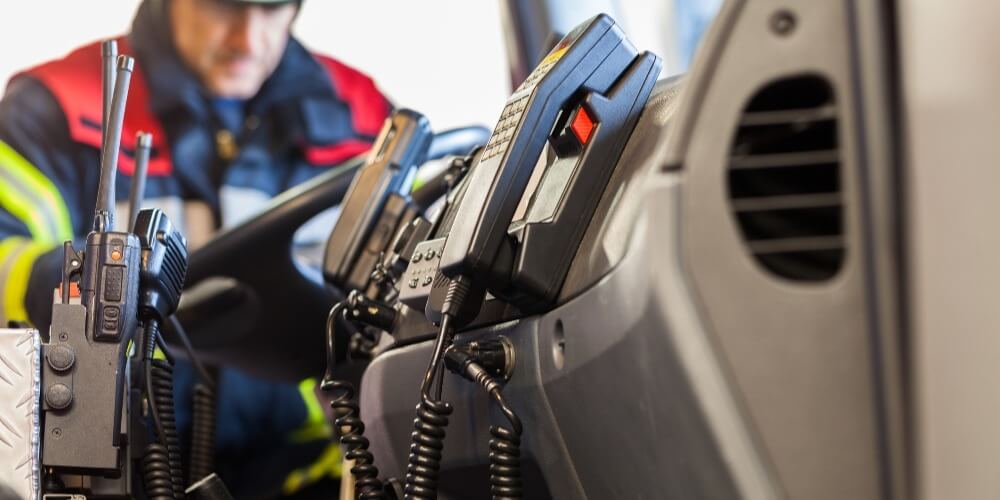We’ve all seen the commercials that show us how quickly 5G can stream a video. But it’s in the professional world where 5G will be transformative. That’s especially true for the public safety sector, where 5G makes life-saving applications possible, like real-time drone surveillance, enhanced vision for firefighters in smoky rooms, and crisis negotiation robots.
5G is positioned to help empower a safer society by supporting the development of new public safety applications and by enhancing emergency responder radio communications systems (ERRCS), including public safety distributed antenna systems (DAS).
Before explaining how 5G will improve public safety, let’s briefly review 5G.
What is 5G?
5G is the fifth generation of wireless data technology. Just as the jump from 1G to 2G cell phone technology added the ability to text and 3G made smartphones possible, the introduction of 5G will bring capabilities not possible with the current 4G and 4G LTE technologies. For example, 5G is projected to enhance pre-existing technology such as distributed antenna systems (DAS) and provide new capabilities like helping first responders access real-time data.
5G opens the door to new and innovative public safety applications and technologies because of its high network speed and lower latency. Here’s a bit more on those two terms.
High network speed - Most consumers understand this metric. Higher speeds mean less time to download large files, such as movies. For public safety agencies, higher network speeds will make it possible to send large amounts of data (such as high-definition video) over the wireless network in real-time.
Low latency - Latency is the time it takes a network to respond to a request. For example, CNET, a technology news website, describes latency as “the lag between the moment you try to shoot a space invader and the moment the internet server hosting the game tells your app whether you succeeded.” 5G promises to cut latency down to 1-2 milliseconds, which is more than ten times faster than current networks and fast enough to conduct critical life-or-death operations via remote connection.
How Can 5G Improve In-Building Public Safety Communication Systems?
For public safety agencies and the people they protect, 5G will create a whole new category of tools and provide a next-generation upgrade to existing technology such as public safety DAS and bi-directional amplifiers (BDAs). 5G is positioned to improve these tools due to high network speed and lower latency.
The performance upgrade provided by 5G is increasingly significant as property owners need to extend reliable public safety radio communications indoors to adhere to new National Fire Protection Association (NFPA) code regulations that mandate public safety wireless systems in new and existing buildings.
Next-generation in-building public safety communications systems support first-responder radio networks and bring secure connectivity to buildings, including common radio dead zones like stairwells, elevators, and basements. Having a strong, consistent indoor service throughout a facility will be especially important in the coming 5G world.
A 5G-ready in-building public safety communication system, meaning it will continue to provide reliable in-building cellular connectivity and require little modification as 5G becomes more widely available, can:
- Support 5G upgrades
- Align with most emergency notification systems
- Expedite emergency response time
- Improve the ability to call 911 throughout the building
- Enable better emergency personnel coordination
- Ensure public safety codes and ordinances are met
What are the Main 5G Public Safety Applications?
Some of the specific fire fighting, EMS, and police applications for 5G are currently in development. Earlier this year, Verizon announced a list of companies that are developing police and fire 5G applications at the wireless provider’s 5G First Responder Lab. The initial spots in Verizon’s program went to the following five companies.
- Adcor Magnetic Systems - Sensors to detect, identify, track and correlate on a digital 3D environment.
- Aerial Applications - Drone solutions to turn visual data into actionable insights.
- Blueforce Development - Situational awareness solutions and sensors to enhance field operations and communication.
- Kiana Analytics - A physical safety and security platform with engagement analytics for real-time location/situational awareness.
- Qwake Technologies - Augmented reality products to help firefighters see in smoke-filled, zero-visibility, and hazardous environments.
Prepare for 5G with a Reliable In-Building Public Safety Solution
While 5G is here for some, it will likely be years before it’s widely available because the super-high frequency spectrum that allows 5G to transmit data comes with the drawback of a shorter range than 4G networks. That means wider 5G availability will require a massive national 5G infrastructure build-out that may take several years to reach some police and fire departments.
Because of this, emergency service professionals should familiarize themselves with the coming 5G capabilities but shouldn’t delay communication system upgrades that use the current 4G technology.
One key existing technology facility managers in all types of venues should consider implementing today is a public safety DAS built on 4G service. Facility managers should partner with a premier integrator to design, install, maintain, and monitor an in-building public safety communication system that is 5G ready, multi-carrier capable, and supported by experienced technicians 24/7.
Experienced technicians design ERRCS solutions based on the spectrum environment (the radio frequencies used locally by first responders), building parameters such as wall types, thickness, and building materials, and the local authority having jurisdiction’s (AHJ) code requirements to ensure successful implementation.
Editor's Note: This post was originally published on January 03, 2020, and has been updated for accuracy and current best practices.





